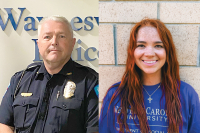Bridging the gap between young, old
 With each passing day, the first-person accounts of what life was like in the Smokies before Google, iTunes or even black-and-white television slip away. So, Beth Bramhall, a seasonal education ranger with Great Smoky Mountains National Park, decided to recruit the next generation to stem the tide of such loss.
With each passing day, the first-person accounts of what life was like in the Smokies before Google, iTunes or even black-and-white television slip away. So, Beth Bramhall, a seasonal education ranger with Great Smoky Mountains National Park, decided to recruit the next generation to stem the tide of such loss.
The result was “Passing It On: A Digital Storytelling Project,” a year’s worth of old-timers’ stories collected and compiled digitally by area middle- and high-school students who were helped along by their teachers, park staff, local experts and folks from the Great Smoky Mountains Association.
Bramhall was pleased with the result, and the fact that there were still stories to collect.
“I remember thinking what a shame it was that the old-timers and former Civilian Conservation Corps members were disappearing,” Bramhall said. “The time to talk with these folks is now, while they’re still around to tell their stories first hand.”
The idea for “Passing It On” came to Bramhall during hikes she’d take in the Greenbrier section of the national park, where she’d often meet and have a chance to talk with “old-timers” who remembered what it was like to grow up in the early part of the 20th century in the mountain region that became the park in 1934. Bramhall thought it would be a perfect fit to send students into the field, equipped with the latest audio-visual equipment, to catalog the stories and ensure their survival.
Related Items
SEE ALSO: Great Smoky Mountains Association looks back
The first step, however, was to get their teachers even more excited about the curriculum possibilities of such a project. Following a history and digital storytelling workshop, which attracted nearly 30 teachers from Tennessee and North Carolina, Bramhall was able to recruit several to sign on to the project. They took the idea of digital storytelling back to their classrooms.
Once hooked by the latest bells and whistles, including movie-making software, sound equipment and digital cameras, students took the project to heart and began to collect stories about the past. Some could even interview their own family members. Meanwhile, teachers oversaw the classroom research and story development.
Brenda Williams at Robbinsville High School and Kathy Wiggins at Swain County High both participated in the project, as well as teachers from Tennessee.
“I loved being able to focus students on their heritage, their place in it and the place of story,” said Wiggins, a self-declared “cybrarian.” “The technology was challenging. With several platforms being used, it was hard to nail down the best fit, but the end results were great.”
Wiggins, who said the project gave her an opportunity to honor her grandmother, plans to offer a similar curriculum to future students, but maybe on a slightly smaller scale.
The result was digital storytelling that mixes a narrator’s voice, still photographs that appear to move through camera sweeps, forgotten letters written to loved ones, old maps outlining boundaries, and mountain-style music that creates the mood and, of course, the words and memories straight from the men and women who lived the experience.
“Basically, it’s the high-tech version of an ancient art form,” Bramhill said. “The idea is still to tell a great story, just using all the art forms available.”
Whether it was helping to move a community church out of the new national park or playing a game of Native American medicine ball or living in a Civilian Conservation Corps camp, the stories are compelling. The project was even declared winner of this year’s Association of Partners of Public Lands awards in the educational program category. And the park is trying to find ways to make use of the stories.
“I think everyone was amazed at how much information these kids uncovered about the pre-park Smokies,” said Steve Kemp, interpretive products and services director for Great Smoky Mountains Association, the agency that oversaw the project and administered the grant for it. “I’ve been researching and writing about this area for over 25 years, and I learned things from their videos.”









